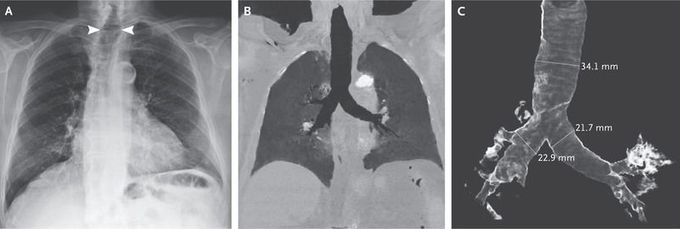


Tracheobronchomegaly
An 84-year-old man with symptomatic severe aortic-valve stenosis was admitted for transapical aortic-valve implantation to be performed while the patient was under general anesthesia. He had a history of chronic bronchitis and recurrent respiratory infections. After endotracheal intubation and tube-cuff inflation, a severe peritubal air leak was identified. Three reintubations were performed until a large 9.0-mm tube was finally placed that limited leakage to a clinically acceptable value. A preoperative chest radiograph was reassessed, and postoperative computed tomography confirmed tracheobronchomegaly (Panel A, arrowheads, and Panels B and C). This rare congenital condition, described by Mounier-Kuhn in 1932, is characterized by marked dilatation of the trachea and the main bronchi and is associated with recurrent infection of the lower respiratory tract. In most cases there is also peripheral bronchiectasis, which was not present in this patient. The tracheobronchial dilatation is caused by atrophy of the elastic and smooth-muscle fibers of the tracheal and main bronchial walls. In this patient, despite successful implantation of an aortic valve, the postoperative period in the intensive care unit was complicated by septic shock and multiorgan failure. He died on postoperative day 25.

